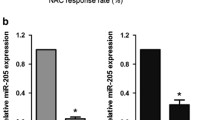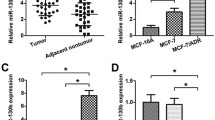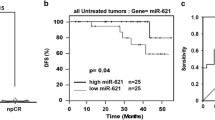Abstract
Drug resistance remains a major clinical obstacle to successful treatment in breast cancer patients, and the evidence of microRNAs involvement in cancer drug resistance has been emerging recently. However, the role of microRNA-200c (miR-200c) in modulating chemoresistance of breast cancer remains largely unexplored. Here, we investigated the miR-200c expression in tumor specimens obtained from thirty-nine breast cancer patients who received neoadjuvent chemotherapy by quantitative real-time PCR. Down-regulated miR-200c was observed in non-responders as compared to responders. In addition, miR-200c expression was observed to be down-regulated over 800-fold in human breast cancer cells resistant to doxorubicin MCF-7/ADR as compared to the parental MCF-7 cells. Up-regulation of miR-200c with transfection of miR-200c mimics in breast cancer cells could enhance the chemosensitivity to epirubicin and reduce expression of multidrug resistance 1 mRNA and P-glycoprotein. Moreover, our study demonstrated that restoration of miR-200c in MCF-7/ADR cells could increase intracellular doxorubicin accumulation determined by flow cytometry. Taken together, our findings suggest that miR-200c may act as a promising therapeutic target for improvement of responsiveness to chemotherapy in breast cancer.




Similar content being viewed by others
References
Ng EK, Wong CL, Ma ES, Kwong A. MicroRNAs as new players for diagnosis, prognosis, and therapeutic targets in breast cancer. J Oncol. 2009;2009:305420.
Calin GA, Sevignani C, Dumitru CD, Hyslop T, Noch E, et al. Human microRNA genes are frequently located at fragile sites and genomic regions involved in cancers. Proc Natl Acad Sci USA. 2004;101(9):2999–3004.
Bartel DP. MicroRNAs: genomics, biogenesis, mechanism, and function. Cell. 2004;116(2):281–97.
Lim LP, Lau NC, Garrett-Engele P, Grimson A, Schelter JM, et al. Microarray analysis shows that some microRNAs downregulate large numbers of target mRNAs. Nature. 2005;433(7027):769–73.
Si ML, Zhu S, Wu H, Lu Z, Wu F, Mo YY. Mir-21-mediated tumor growth. Oncogene. 2007;26(19):2799–803.
Kastl L, Brown I, Schofield AC. Mirna-34a is associated with docetaxel resistance in human breast cancer cells. Breast Cancer Res Treat. 2011.
Akao Y, Noguchi S, Iio A, Kojima K, Takagi T, Naoe T. Dysregulation of microRNA-34a expression causes drug-resistance to 5-fu in human colon cancer dld-1 cells. Cancer Lett. 2011;300(2):197–204.
Miller TE, Ghoshal K, Ramaswamy B, Roy S, Datta J, et al. MicroRNA-221/222 confers tamoxifen resistance in breast cancer by targeting p27kip1. J Biol Chem. 2008;283(44):29897–903.
O’Driscoll L, Clynes M. Biomarkers and multiple drug resistance in breast cancer. Curr Cancer Drug Targets. 2006;6(5):365–84.
Takara K, Sakaeda T, Okumura K. An update on overcoming mdr1-mediated multidrug resistance in cancer chemotherapy. Curr Pharm Des. 2006;12(3):273–86.
Adam L, Zhong M, Choi W, Qi W, Nicoloso M, et al. Mir-200 expression regulates epithelial-to-mesenchymal transition in bladder cancer cells and reverses resistance to epidermal growth factor receptor therapy. Clin Cancer Res. 2009;15(16):5060–72.
Ceppi P, Mudduluru G, Kumarswamy R, Rapa I, Scagliotti GV, et al. Loss of mir-200c expression induces an aggressive, invasive, and chemoresistant phenotype in non-small cell lung cancer. Mol Cancer Res. 2010;8(9):1207–16.
Therasse P, Arbuck SG, Eisenhauer EA, Wanders J, Kaplan RS, et al. New guidelines to evaluate the response to treatment in solid tumors. European organization for research and treatment of cancer, national cancer institute of the United States, national cancer institute of Canada. J Natl Cancer Inst. 2000;92(3):205–16.
Paik JH, Jang JY, Jeon YK, Kim WY, Kim TM, et al. MicroRNA-146a downregulates nfkappab activity via targeting traf6 and functions as a tumor suppressor having strong prognostic implications in nk/t cell lymphoma. Clin Cancer Res. 2011;17(14):4761–71.
Chintamani JPS, Mittal MK, Saxena S, Bansal A, et al. Role of p-glycoprotein expression in predicting response to neoadjuvant chemotherapy in breast cancer—a prospective clinical study. World J Surg Oncol. 2005;3:61.
Yan LX, Huang XF, Shao Q, Huang MY, Deng L, et al. MicroRNA mir-21 overexpression in human breast cancer is associated with advanced clinical stage, lymph node metastasis and patient poor prognosis. Rna. 2008;14(11):2348–60.
Xu D, Lu Q, Hu X. Down-regulation of p-glycoprotein expression in mdr breast cancer cell mcf-7/adr by honokiol. Cancer Lett. 2006;243(2):274–80.
Zhu H, Wu H, Liu X, Evans BR, Medina DJ, et al. Role of microRNA mir-27a and mir-451 in the regulation of mdr1/p-glycoprotein expression in human cancer cells. Biochem Pharmacol. 2008;76(5):582–8.
Chen J, Lu L, Feng Y, Wang H, Dai L, et al. Pkd2 mediates multi-drug resistance in breast cancer cells through modulation of p-glycoprotein expression. Cancer Lett. 2011;300(1):48–56.
Kent OA, Mendell JT. A small piece in the cancer puzzle: micrornas as tumor suppressors and oncogenes. Oncogene. 2006;25(46):6188–96.
Lewis BP, Burge CB, Bartel DP. Conserved seed pairing, often flanked by adenosines, indicates that thousands of human genes are microRNA targets. Cell. 2005;120(1):15–20.
Korpal M, Lee ES, Hu G, Kang Y. The mir-200 family inhibits epithelial-mesenchymal transition and cancer cell migration by direct targeting of e-cadherin transcriptional repressors zeb1 and zeb2. J Biol Chem. 2008;283(22):14910–4.
Xia H, Ng SS, Jiang S, Cheung WK, Sze J, et al. Mir-200a-mediated downregulation of zeb2 and ctnnb1 differentially inhibits nasopharyngeal carcinoma cell growth, migration and invasion. Biochem Biophys Res Commun. 2010;391(1):535–41.
Leskela S, Leandro-Garcia LJ, Mendiola M, Barriuso J, Inglada-Perez L, et al. The mir-200 family controls beta-tubulin iii expression and is associated with paclitaxel-based treatment response and progression-free survival in ovarian cancer patients. Endocr Relat Cancer. 2011;18(1):85–95.
Gottesman MM, Ling V. The molecular basis of multidrug resistance in cancer: the early years of p-glycoprotein research. FEBS Lett. 2006;580(4):998–1009.
Kovalchuk O, Filkowski J, Meservy J, Ilnytskyy Y, Tryndyak VP, et al. Involvement of microRNA-451 in resistance of the mcf-7 breast cancer cells to chemotherapeutic drug doxorubicin. Mol Cancer Ther. 2008;7(7):2152–9.
Zheng T, Wang J, Chen X, Liu L. Role of microrna in anticancer drug resistance. Int J Cancer. 2010;126(1):2–10.
Cochrane DR, Howe EN, Spoelstra NS, Richer JK. Loss of mir-200c: a marker of aggressiveness and chemoresistance in female reproductive cancers. J Oncol. 2010;2010:821717.
Tryndyak VP, Beland FA, Pogribny IP. E-cadherin transcriptional down-regulation by epigenetic and microrna-200 family alterations is related to mesenchymal and drug-resistant phenotypes in human breast cancer cells. Int J Cancer. 2010;126(11):2575–83.
Li Y, VandenBoom TN, Kong D, Wang Z, Ali S, et al. Up-regulation of mir-200 and let-7 by natural agents leads to the reversal of epithelial-to-mesenchymal transition in gemcitabine-resistant pancreatic cancer cells. Cancer Res. 2009;69(16):6704–12.
Conflict of interest
None.
Author information
Authors and Affiliations
Corresponding author
Rights and permissions
About this article
Cite this article
Chen, J., Tian, W., Cai, H. et al. Down-regulation of microRNA-200c is associated with drug resistance in human breast cancer. Med Oncol 29, 2527–2534 (2012). https://doi.org/10.1007/s12032-011-0117-4
Received:
Accepted:
Published:
Issue Date:
DOI: https://doi.org/10.1007/s12032-011-0117-4




